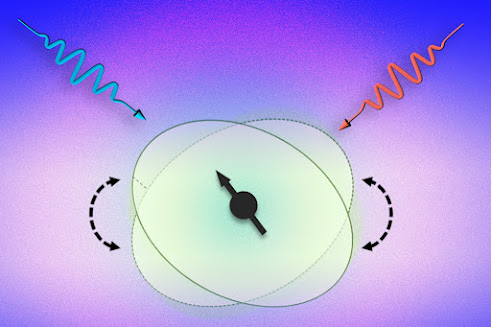 |
| Diagram illustrates the way two laser beams of slightly different wavelengths can affect the electric fields surrounding an atomic nucleus, pushing against this field in a way that nudges the spin of the nucleus in a particular direction, as indicated by the arrow. Illustration Credit: Courtesy of the researchers | MIT Creative Commons |
In principle, quantum-based devices such as computers and sensors could vastly outperform conventional digital technologies for carrying out many complex tasks. But developing such devices in practice has been a challenging problem despite great investments by tech companies as well as academic and government labs.
Today’s biggest quantum computers still only have a few hundred “qubits,” the quantum equivalents of digital bits.
Now, researchers at MIT have proposed a new approach to making qubits and controlling them to read and write data. The method, which is theoretical at this stage, is based on measuring and controlling the spins of atomic nuclei, using beams of light from two lasers of slightly different colors. The findings are described in a paper published Tuesday in the journal Physical Review X, written by MIT doctoral student Haowei Xu, professors Ju Li and Paola Cappellaro, and four others.
Nuclear spins have long been recognized as potential building blocks for quantum-based information processing and communications systems, and so have photons, the elementary particles that are discreet packets, or “quanta,” of electromagnetic radiation. But coaxing these two quantum objects to work together was difficult because atomic nuclei and photons barely interact, and their natural frequencies differ by six to nine orders of magnitude.


.jpg)



.jpg)









.jpg)